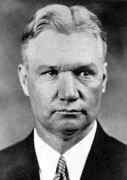Person: Moore (3), Robert Lee

Robert Lee Moore was an American mathematician, known for his work in general topology and the "Moore method" of teaching university mathematics.
Mathematical Profile (Excerpt):
- Robert received a good education at a private high school in Dallas, and before he entered university he had learnt university level calculus by studying the university textbooks.
- He graduated with a Sc.B. in 1901 and after a year as a teaching fellow at the University of Texas, Moore spent the academic year 1902-03 as a mathematics instructor at the High School in Marshall, Texas.
- Moore would have remained at the University of Texas rather than spend the year teaching in a high school but, for some reason which is not clear, the university regents refused to renew his appointment despite strong protests from Halsted.
- Halsted had suggested a problem in one of his classes which had led Moore to prove that one of Hilbert's geometry axioms was redundant.
- Eliakim Moore, who was the head of mathematics at Chicago University, heard of this contribution and, since his research interests at the time were precisely on the foundations of geometry, Eliakim Moore organised the award of a scholarship that would allow Robert Moore to study for his doctorate in Chicago.
- We should note that despite the fact that Eliakim Moore and Robert Moore shared the same surname and the same research interests, they were not related.
- Veblen supervised Moore's Ph.D. at University of Chicago and the degree was awarded in 1905 for a dissertation entitled Sets of Metrical Hypotheses for Geometry.
- Moore spent the year 1905-06 as an assistant professor at the University of Tennessee, then two years as an instructor at Princeton University.
- It was at the University of Pennsylvania that Moore first tried out his teaching methods in a Foundations of Geometry course he taught there.
- We shall describe the Moore Method below.
- Moore was appointed to the staff at the University of Texas in 1920 as an associate professor, being made a full professor three years later.
- Moore was delighted to return to the University of Texas, his home university.
- For his doctoral thesis Moore had worked on the foundations of topology.
- Moore wrote up his work on point-set topology in the important book Foundations of point set topology published in 1932.
- This volume, published in the Colloquium Lectures Series of the American Mathematical Society, arose from the colloquium lectures which Moore gave in 1929 and is a self-contained introduction to the topic concentrating on Moore's own contributions to the subject.
- We should comment on Moore's teaching methods, for their success influenced others to use similar methods.
- Moore sternly prevented heckling.
- Moore would then ask the next student to try or if he thought the difficulty encountered was sufficiently interesting, he would save that theorem until next time and go on to the next unproved theorem (starting again at the bottom of the class).
- Moore taught at the University of Texas until he was 86 years old, and he wished to carry on teaching but the University authorities forced him to retire.
- The University of Texas did Moore a great honour, however, for in 1973 they named a new physics, mathematics and astronomy building after him.
- A strong supporter of the American Mathematical Society, Moore was an editor of the Colloquium Publications from 1929 to 1936, being editor-in-chief from 1930 to 1933.
Born 14 November 1882, Dallas, Texas, USA. Died 4 October 1974, Austin, Texas, USA.
View full biography at MacTutor
Tags relevant for this person:
Origin Usa, Topology
Thank you to the contributors under CC BY-SA 4.0! 

- Github:
-

- non-Github:
- @J-J-O'Connor
- @E-F-Robertson
References
Adapted from other CC BY-SA 4.0 Sources:
- O’Connor, John J; Robertson, Edmund F: MacTutor History of Mathematics Archive
